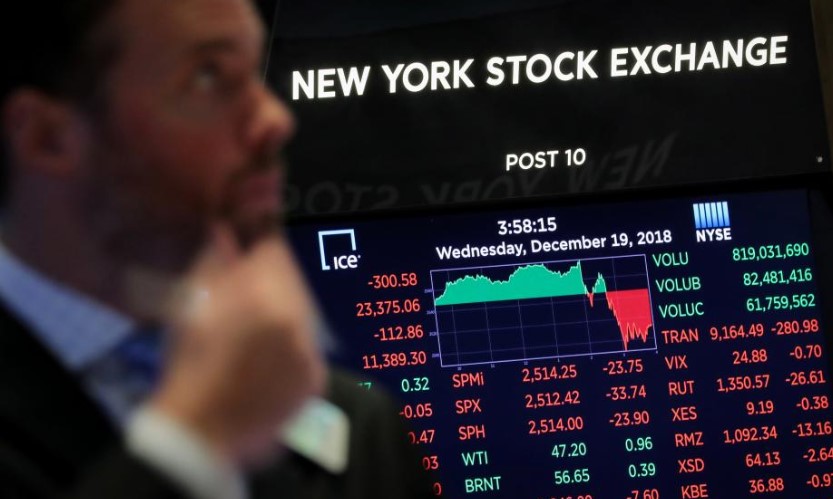
U.S. stocks declined sharply on Wednesday after the Federal Reserve’s forecast of fewer interest-rate increases in 2019 fell short of investors’ hopes of a more dovish monetary policy.
The Dow Industrials .DJI closed at their lowest level since November 2017. The Dow Transports .DJT plunged 3.2 percent to confirm bear market territory, down nearly 21 percent from their record high on Sept. 14.
The benchmark S&P 500 index .SPX is now down 14.5 percent from its record closing high on Sept. 20. Of its components, 298 have fallen 20 percent or more from their 52-week highs. On the New York Stock Exchange and the Nasdaq, more than 2,000 stocks hit 52-week lows on Wednesday.
Stocks initially seesawed after the Fed’s Federal Open Market Committee released its policy statement but accelerated losses after Fed Chairman Jerome Powell spoke at a news conference.
Investors said Powell’s remarks that he did not see the central bank changing its policy of keeping its balance sheet run-off on “autopilot” raised concerns of tightening financial conditions placing further strain on financial markets.
“Powell is steadfast in his commentary today that he doesn’t see any tightening that stems from the unwinding of the balance sheet,” said Quincy Krosby, chief market strategist at Prudential Financial in Newark, New Jersey. “The market message is we are seeing tighter financial conditions and a weaker path for growth.”
And while the Fed now expects two rate hikes in 2019, down from three in its previous economic forecasts in September, investors said the slower pace was not enough to calm concerns about the possible negative effects of rising rates as economic growth slackens.
“The market is just kind of recognizing the Fed is not throwing them a lifeline anytime soon,” said Michael O’Rourke, chief market strategist at JonesTrading in Greenwich, Connecticut.
The Dow Jones Industrial Average .DJI fell 351.98 points, or 1.49 percent, to 23,323.66, the S&P 500 .SPX lost 39.2 points, or 1.54 percent, to 2,506.96 and the Nasdaq Composite .IXIC dropped 147.08 points, or 2.17 percent, to 6,636.83.
All of the S&P 500’s major sectors fell. Utilities .SPLRCU, real estate .SPLRCR and consumer staples .SPLRCS posted the smallest percentage declines. The defensive sectors have risen as U.S. stocks have become more volatile in recent months. With Wednesday’s losses, only utilities and healthcare .SPXHC were in positive territory for the year.
The members of the FAANG group of momentum stocks, which helped lift the Nasdaq on Tuesday, all registered losses. Shares of Amazon.com Inc (AMZN.O), Apple Inc (AAPL.O) and Facebook Inc (FB.O) all fell more than 3 percent.
Facebook shares dropped 7.3 percent, their biggest percentage decline since July. The New York Times reported that the social media giant allowed some companies far greater access to data than disclosed. The company said the access was provided only after user permission.
Shares of FedEx Corp (FDX.N), seen as a bellwether for the U.S. economy, sank 12.2 percent, its biggest one-day drop in 10 years, after the logistics company slashed its 2019 forecast.
Micron Technology Inc (MU.O) shares fell 7.9 percent after the chipmaker gave a tepid forecast that exacerbated fears the industry’s boom was fizzling out.
Declining issues outnumbered advancing ones on the NYSE by a 2.58-to-1 ratio; on Nasdaq, a 2.93-to-1 ratio favored decliners.
The S&P 500 posted no new 52-week highs and 135 new lows; the Nasdaq Composite recorded six new highs and 625 new lows.
Volume on U.S. exchanges was 10.81 billion shares, compared to the 8.22 billion average over the last 20 trading days.